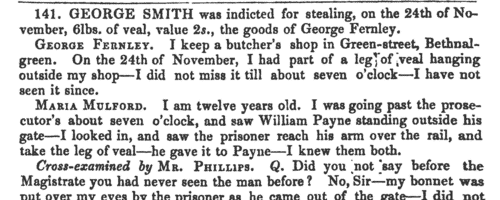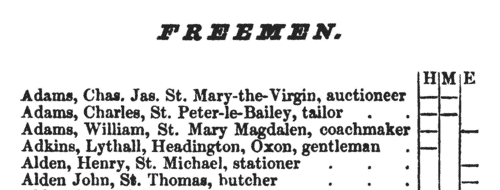Patey Surname Ancestry ResultsOur indexes 1000-1999 include entries for the spelling 'patey'. In the period you have requested, we have the following 169 records (displaying 51 to 60): Single Surname Subscription | | | Buying all 169 results of this search individually would cost £936.00. But you can have free access to all 169 records for a year, to view, to save and print, for £100. Save £836.00. More... |
These sample scans are from the original record. You will get scans of the full pages or articles where the surname you searched for has been found. Your web browser may prevent the sample windows from opening; in this case please change your browser settings to allow pop-up windows from this site. London and Middlesex crimes tried at the Central Criminal Court: the accused
(1836)
Henry Buckler copied in shorthand the proceedings of trials at the Central Criminal Court in London, and his transcripts were printed. This volume (iii), from 1836, covers sessions i to vi of the Copeland mayoralty of 1835 to 1836. The bulk of the cases were from London and Middlesex, with separate sections for Essex, Kent and Surrey, but, preceding all these, Capital Convictions. The names of the accused are annotated with an asterisk to show if they had previously been in custody; an obelisk indicates a known associate of bad characters. Most cases resulted in a guilty verdict, and a large proportion of these led to a sentence of transportation to Australia. This index covers those accused in the London and Middlesex cases of April 1836.PATEY. Cost: £6.00.  | Sample scan, click to enlarge

| Non-Freemen Voters in Oxford: St Peter in the East
(1837)
A poll of the freemen and non-freemen electors of the City of Oxford took place on 25 July 1837, the candidates being William Hughes Hughes (H), Donald Maclean (M) and William Erle (E). This poll book lists all 2145 voters, as well as those electors who did not vote. In both cases, the lists are divided into a single register of freemen, and then the non-freemen arranged by parish or ward - All Saints, Cowley, Holywell, St Aldate, St Clement, St Ebbe, St Giles, St John, St Martin, St Mary Magdalen, St Mary the Virgin, St Michael, St Peter in the East, St Peter le Bailey, and St Thomas. The votes of those who voted are shown on the right hand side of the page. The names of the freemen are given with address and occupation; those of non-freemen with address, but without stating occupation.PATEY. Cost: £4.00.  | Sample scan, click to enlarge

| Officers of the British Army
(1840)
The New Annual Army List, corrected to 7 February 1840, was published in London by Lieut. H. G. Hart. It lists all serving officers, first of all a list of General and Field Officers by rank from field marshal down to major; and then by regiment, including all ranks down to ensign, with paymasters, adjutants, quarter-masters, surgeons and assistant-surgeons. These lists are all annotated with dates of rank in the army and regiment, and with symbols indicating the officers present at Trafalgar (T), in the Peninsula or the South of France (P), and Waterloo (W). A superscript p indicates that the commission was purchased; an asterisk that it was temporary. The regiments and units are listed in order of precedence: Head Quarters staff; Life Guards; Horse Guards; 7 regiments of Dragoon Guards; 17 regiments of Dragoons; 98 regiments of Foot; the Rifle Brigade; two West India regiments of Foot; Ceylon Rifles; Royal African Colonial Corps; Cape Mounted Rifles; Royal Newfoundland Veterans; Royal Malta Fencibles; Recruiting Staff; Royal Artillery; Royal Engineers; Royal Marines; Commissariat; and the Medical Department. PATEY. Cost: £4.00.  | Sample scan, click to enlarge

| British sea officers
(1841)
The Royal Kalendar lists the 177 flag officers of the Royal Navy; the 670 captains (including superannuated and retired) and 751 commanders. The captains and commanders are given in order of precedence, determined by the dates of their appointment. Then there is a list of the ships of the navy, annotated with the names of their captains, with a separate section for steam vessels; packet brigs at Falmouth; and mail steam vessels at Dover, Weymouth, Pembroke, Liverpool, Holyhead and Portpatrick.PATEY. Cost: £6.00.  | Sample scan, click to enlarge

| Householders of the parish of St Peter in the East in the city of Oxford
(1841)
A parliamentary poll of the freemen and electors of the City of Oxford was taken 30 June 1841, the candidates being Donald Maclean (Mac), James Haughton Langston (Lan) and Neill Malcolm (Mal). The poll book records the names, addresses and occupations of the householders, district by district, as well as the names of the freemen of the city, and shows for whom they voted.PATEY. Cost: £6.00.  | Sample scan, click to enlarge

|  London Policemen
(1830-1842) London Policemen
(1830-1842)
The Metropolitan Police Register of Joiners (MEPO 333/4) lists policemen joining the force through to 31 December 1842 (to warrant number 19892). The register is alphabetical, in so far as the recruits are listed chronologically grouped under first letter of surname. It is evidently a continuation of a similar earlier register, not closed until its alphabetical sections were filled: consequently, there are no entries in this register for the initial letters N, O, Q, U, V, X, Y or Z; and the sections of this register start at different dates - A 18 April 1840 (warrant number 16894); B 11 December 1830 (5570); C 7 September 1830 (4988); D 27 May 1833 (8445); E 15 December 1838 (14476); F 30 March 1832 (7372); G 1 December 1835 (11,184); H 25 April 1832 (7457); I and J 13 February 1837 (12449); K 2 January 1838 (13457); L 3 October 1834 (9905); M 15 November 1832 (7999); P 4 October 1831 (6869); R 4 September 1837 (13021); S 30 March 1835 (10366); T 6 April 1840 (16829); W 30 December 1833 (9096). The register gives Date of Appointment, Name, Number of Warrant, Cause of Removal from Force (resigned, dismissed, promoted or died), and Date of Removal. Although the register was closed for new entrants at the end of 1842, the details of removals were always recorded, some being twenty or more years later. Those recruits not formerly in the police, the army, or some government department, were required to provide (normally) at least two letters of recommendation from persons of standing, and details of these are entered on the facing pages: the names in these are indexed separately - this index refers only to the police constables. Where a recruit was only recently arrived in the metropolis, the names and addresses of the recommenders can be invaluable for tracing where he came from.PATEY. Cost: £8.00.  | Sample scan, click to enlarge

| Dissolutions of Partnerships
(1844)
Trade partnerships dissolved, or the removal of one partner from a partnership of several traders, in England and Wales
PATEY. Cost: £6.00.  | Sample scan, click to enlarge

| Mathematics students at Cambridge University
(1844)
Tripos lists or examination results for the year, arranged by class (Wranglers, Senior Optimes and Junior Optimes), and within each class in order of score in the examination (the names of candidates with equal scores are bracketed together, with the word 'AEq.'). Each student's surname and college is given: this list was printed in 1890, and was annotated with asterisks to show which students had subsequently become fellows of the university; and with footnotes showing those who became headmasters, &c., elsewhere. Winners of Dr Smith's Mathematical Prizes are marked (1) senior, (2) for junior. The Greek letter alpha is affixed to the names of those students who had gained first class results in the Classical Tripos; beta to those entered in the second class; and gamma to those entered in the third class. These lists are particularly useful in identifying for an individual the fellow-students who will have attended lectures with him; and, where from the college, are likely to have been even more closely associated by having been under the same supervisor. (The sample scan is from the start of the Mathematics Tripos list for 1770)PATEY. Cost: £6.00.  | Sample scan, click to enlarge

| Graduates of Cambridge University
(1760-1846)
Joseph Romilly, registrar of the university of Cambridge, compiled Graduati Cantabrigienses, a catalogue of graduates from the academic year of admissions 1760 through to 10 October 1846. The names are arranged alphabetically by surname, and then chronologically by christian name: the college is given, with an asterisk in those cases where the man became a fellow, and then, in chronological order, his degrees. PATEY. Cost: £4.00.  | Sample scan, click to enlarge

| Insolvents in bankruptcy in England and Wales
(1846)
Perry's Bankrupt and Insolvent Gazette, issued monthly, included lists of insolvents petitioning the courts of bankruptcy, together with subsequent stages in their discharge. The insolvent is generally referred to by name (surname first, in capitals), address and trade. The initial notice of the petition gives the surnames of the Commissioner and the Official Assignee. This is the index to the names of the insolvents, from the issues from January to December 1846.PATEY. Cost: £6.00.  | Sample scan, click to enlarge

|
Research your ancestry, family history, genealogy and one-name study by direct access to original records and archives indexed by surname.
|













